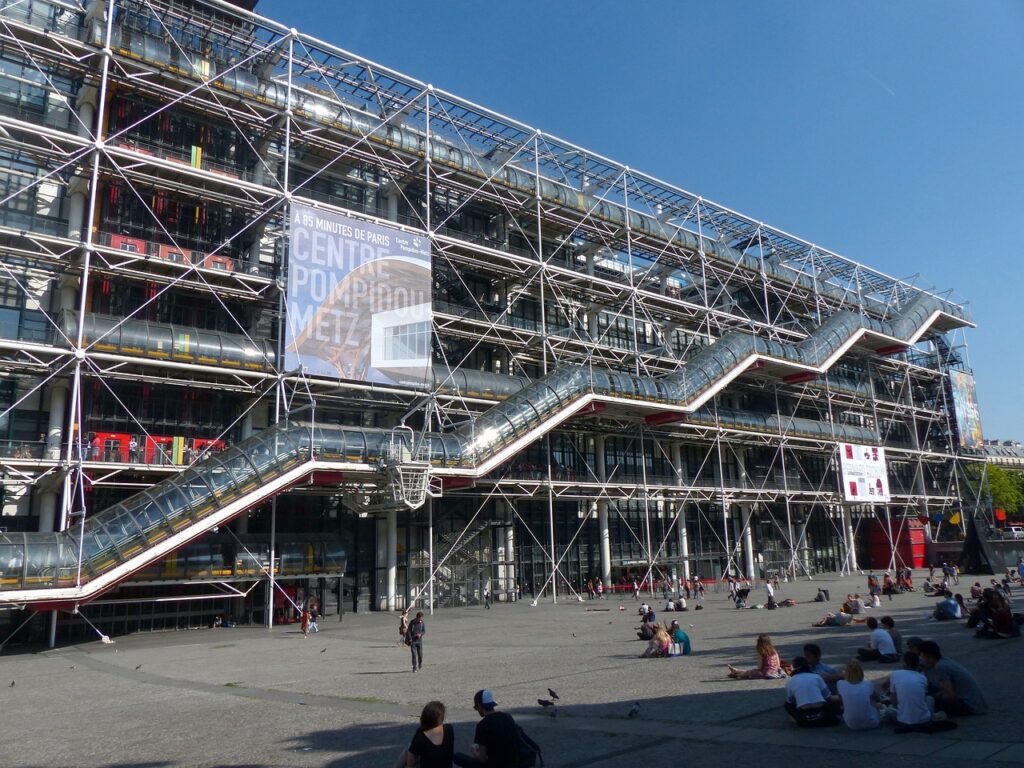Paris does not have a great track record when it comes to welcoming new architecture and/or monuments to its skyline. The Eiffel Tower, the Louvre pyramid, and Opera Bastille are all examples of highly controversial additions over the years. Most were loathed at first sight. Some, like the Tour Montparnasse, are still loathed by both Parisians and visitors alike. And then there’s the Centre Pompidou, Paris’ museum of modern art. I mean, just look at that photo. As you can imagine, it caused a bit of a sensation when it was first unveiled.
The Centre Pompidou was born out of the desire to redevelop the area around Les Halles. The famous 19th century food market was moved out of the city, and a proposal for a new modern art centre was put forth. This art centre was ultimately commissioned by French President Georges Pompidou, hence the name. But first, they needed a design. To find one, a competition was held, which was notable for being the first time that international architects were allowed to participate. Hundreds of entries poured in from around the world, and 1971, the winners were announced. A British-Italian team led by Richard Rogers and Renzo Piano had won. The winning design? A building that was inside out.
I know that sounds ridiculous, but take another look at the photos above and below. Technically, the Centre Pompidou falls under the high-tech style of architecture. But when people see this building, all they tend to see is a building that is inside out. Piping, heating ducts, and wiring are all visible from the exterior. The escalators run up the side of the building. Basically, anything functional is on the outside, leaving an empty box on the inside. This was done on purpose, to allow the artwork to be displayed without any structural features getting in the way.
To say that reactions to the latest addition to Paris’ skyline were mixed would be putting it mildly. Many Parisians were outraged, viewing the building as an eyesore in the heart of the city. National Geographic described it as “love at second sight”, which personally I find hilarious. Because in many ways it’s true. I’ve heard the Centre Pompidou described as outrageous, hideous, and ugly. Someone recently likened it to a parking garage. And yet, it’s also one of city’s most well-loved museums. In fact, it’s the third most visited museum in Paris, with nearly 3.5 million visitors every year.
Which is why the news last week of the Centre Pompidou’s upcoming closure was sad for so many. It was announced that the museum will be closing at the end of 2023 for a three-year top to bottom overhaul. The building hasn’t had any significant upgrades since it opened in 1977, and the choice was to either close completely for three years, or renovate over a seven-year partial closure. Officials ultimately chose the former, as a full closure was determined to be more cost-efficient. This also means that the Centre Pompidou will re-open in time for its 50th anniversary in 2027, looking more beautiful than ever.
When I first heard the news of the Centre Pompidou’s impending closure, my first reaction was to sneak in a visit before that happened. Unfortunately, that’s not possible right now. Like all other cultural spaces in Paris, the Centre Pompidou is already closed as part of safety measures aimed at curbing the spread of COVID-19. But then I read the fine print of the announcement and realized I had until 2023 to get in my visit. Hopefully that’s enough time for everything to re-open. Because whenever that finally happens, a trip to the Centre Pompidou is definitely at the top of my list. I need one more chance to marvel at the ingenuity and uniqueness of that space before it shuts its doors for three years.
Laura Moore is a professional storyteller who loves history and the many stories that make Paris one of the most fascinating cities in the world. Join one of her signature tours to learn the story of a city.




